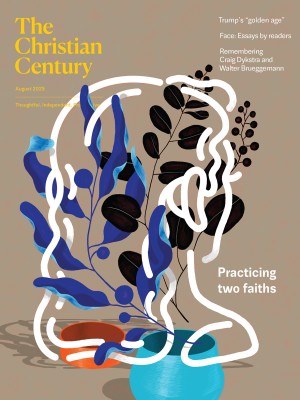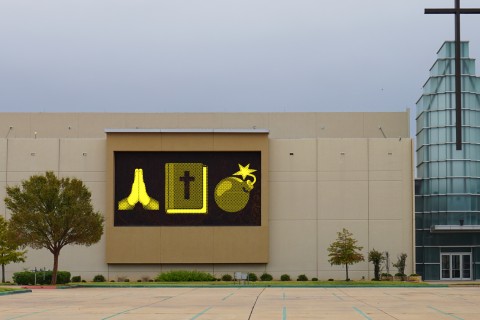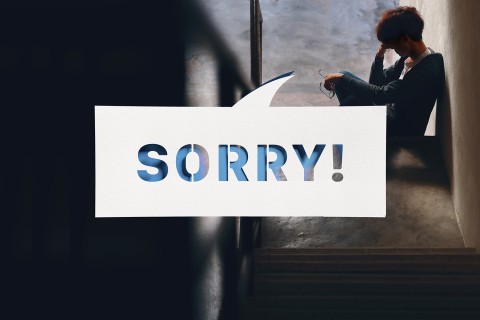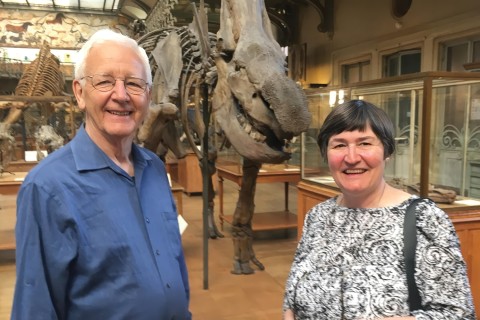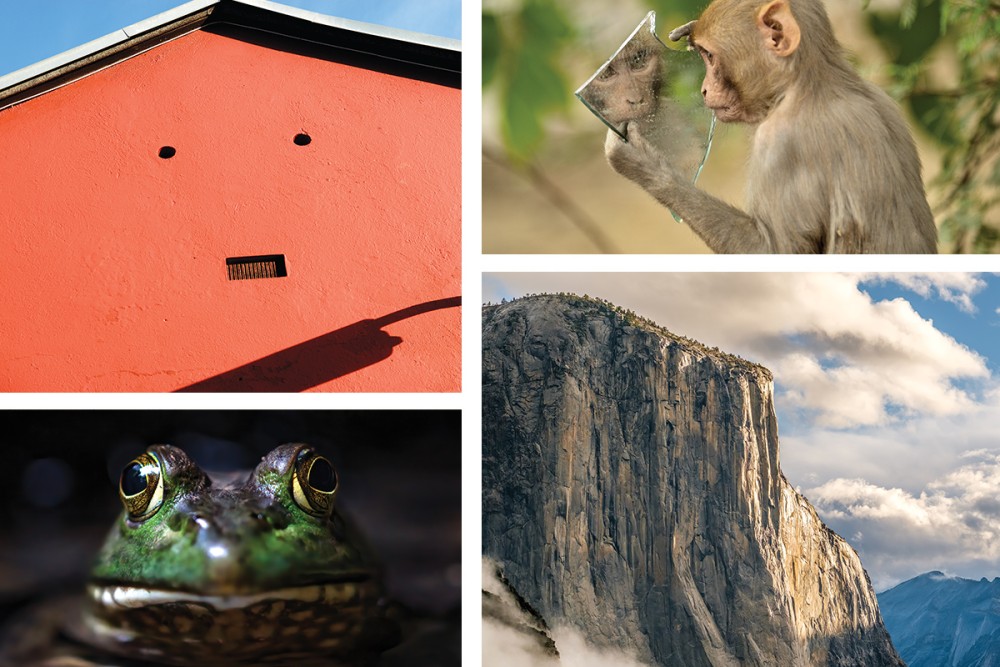
Clockwise from upper left (all from Getty): gaiamoments; Prerna Jain; haveseen; Lavin Photography
The Buechner Narrative Writing Project honors the life and legacy of writer and theologian Frederick Buechner with the aim of nurturing the art of spiritual writing and reflection. Readers are invited to submit first-person narratives (under 1,000 words).
Beauty is to the spirit what food is to the flesh. A glimpse of it in a young face, say, or an echo of it in a song fills an emptiness in you that nothing else under the sun can. Unlike food, however, it is something you never get your fill of.
Read our latest issue or browse back issues.
—Frederick Buechner, Whistling in the Dark
The face is part of our body, but it is also an orientation—a direction. We face our fears, we meet each other face to face, during times of spiritual challenges we learn to face ourselves, and during times of global crisis we are asked to face the problem.
When I think of facing something, I think of Thomas, Jesus’ disciple. To me, Thomas is not the one who doubted so much as the one who had the courage to face his doubt and let it emerge authentically as a guide. We are not privy to the thoughts of the other disciples at the time of the resurrection, but from Thomas we gain a unique glimpse into what it means to face ourselves. Thomas shares his doubt with Jesus, and it is received and mirrored with love, for which Thomas shouts with joy, “My Lord and my God!” Thomas’s courage in facing his doubt is rewarded with a deep experience of a type of divine love and grace.
I struggle with facing doubt, with believing that my doubt will be met with love and grace. I work in international human rights, a career in which I have to directly face many of the worst human-made problems in the world. I am daily faced with the terrible cruelties which my fellow humans who live under brutal regimes must endure.
I have my doubts that the world situation will improve in my lifetime. Although I am a deeply optimistic person—one must have a strong optimism in this field—it is hard not to see and feel our escalating problems and people’s increasing indifference and hostility. And then there is my inner doubt—am I doing enough? How much more can I give and still function?
Yet, the other weekend, I worked with a colleague to support a refugee from Gaza. I had doubts that the work could help, but it was precisely because of that doubt that my colleague and I worked hard and focused on the case.
Later I went for a walk. I felt such joy in my heart for the privilege to work to help others, for the doubt which gave direction and guidance, and for the ability to feel both doubt and hope and not lose faith. Perhaps for some of us, I thought, it is through facing doubt that we come close to the Divine and to the grace which holds us. The sun was shining so bright, for a moment a butterfly danced in my face, and I caught the smell of jasmine. My Lord and my God.
—Cameran Ashraf
Vienna, Austria
I enjoy learning the origins of words that are fun to say. Geezer is one of those words. It comes from guiser, a late 15th-century cockney word that means “disguise.”
A geezer can be someone who has a hopeful, even youthful, attitude toward life and simply lives in the disguise of gray hair and wrinkles. I’ve been spreading that message for the last 15 years in the aging-focused ministry I lead. And people’s faces usually break into grins.
There are geezers all over the world. Our daughter-in-law’s ancestors are from the Mexican state of Michoacán. Before Columbus ever set foot in the Americas, there was a satirical dance tradition in Pátzcuaro, Michoacán, called “La Danza de los Viejitos” (“Dance of the Old Men”). The dancers, disguised in masked “old man” costumes, start with slow movements. As the music speeds up, they perform more and more energetic dance steps. As the dance ends, the masks come off to reveal that many of the dancers are children.
Since 2012 I’ve hosted a geezer forum in my hometown. We gather monthly to explore different aspects of aging and to learn about community resources available for older adults in the area. Many of the participants buy into my encouragement to consider ourselves geezers in training. Regardless of what our faces may reveal about our ages, we have the choice to keep learning what is out there for us.
Our geezer faces even prompt what I like to call go-away-closer humor. It’s the kind of attitude that uses laughter to push our fears to arm’s length—yet still keeps them as close as our wrinkles and gray hair. We’re usually nourished, not diminished, by our masked faces. I often wonder if we’re able to look in the mirror and realize that the younger and older versions of ourselves live together in what we see there. I think it helps if we can laugh at what we see.
—Paul Graves
Sandpoint, ID
“Stop being afraid and face the chicken,” my friend said with a chuckle from the seat of her mobility scooter. She told me that the problem was in my hips. “Your arms are out, but you’re not facing the chicken. It’s like you’re afraid.”
“I am afraid!” I cried as I flailed around my friend’s fenced-in patio chasing the brown hen. “Why won’t she just get back in the carrier herself?”
“I’d show you how to do it, but you’re the one who is supposed to be able-bodied,” she said, now in stitches.
I screamed as the bird hopped up on the gate. “Oh my God, it flies!”
“It’s a bird,” she said, and I could still hear her laughing as I chased the hen down the sidewalk, through the parking lot, and past the business office of the low-income apartment complex. In the end, I never could face the chicken, I could only corner her in a laundry room.
My friend and I had first met years earlier when I worked as her home care provider while I was an MDiv student. She had grown up in rural Pennsylvania and had more affinity for barnyard animals than dogs or cats. She was an activist and a practicing pagan. So while most of my workload was meal prep and laundry, my seminary education was also paid for in part by procuring native plants and spices to be offered to her demigods. It was a fact she loved to point out to me. Our friendship was built on such needling.
Years later she moved to the town where I was working as a pastor. I was serving at a fairly conservative congregation, and as a queer pastor, I felt the need to prove myself every bit as competent as the straight pastors who had come before me. It was a futile project, but I gave it all my time anyway. So it had been awhile since I’d visited my friend when she left me a voicemail saying that she had a cancerous tumor.
We were sharing a beer on her patio the following week when the doctor called to say that the tumor was inoperable. I was holding back tears—not just from grief, but from shame. In my vanity I had prioritized the perception of competency over the practice of compassion. I had been so busy trying to prove myself to those who saw me as less than that I had forsaken someone who knew me as a friend.
I asked her what I could do for her.
“It’s a shame you don’t have a chicken,” she said, and she reminded me about the giant brown hen she had loved as a child. As I was driving home that evening I dialed an 80-year-old, no-nonsense farmer’s daughter in my congregation. It turned out that her sister had just the right chicken, which she delivered to my office in a small plastic carrier the following Monday morning.
She was equally helpful when I called her later that day from my friend’s laundry room, where I had cornered the chicken. “I have it in a corner,” I said, “but I’m afraid of what happens next.”
“You’re doing fine, Pastor!” she said with a laugh. “But seriously, don’t touch the chicken, I’ll be right over.” Some days humility is a heavy burden. Other days it is a gift with feathers.
Near the end of my friend’s life, she and I ran into my congregant and her sister at a thrift store in town. We all laughed as the farmer’s daughters reenacted what I must have looked like trying to catch the hen. They hugged my friend and said they’d pray for her. Even though she was a pagan, she said she’d allow it.
As I was sitting with her on her patio later that day, she said, “I’m afraid of dying.” I was afraid too: afraid of her suffering, afraid of loss. Afraid that I had not done enough for a friend and that I would waste my life trying to prove my worth to those who look down on me.
I tried to share those fears in a way she would understand. “Stop being afraid and face the chicken,” I said, and I began to weep. She allowed me a moment to cry, then took my hand and suggested I use my able body to get us a beer from the fridge.
—Lindsey Bell-Kerr
Sonoma County, CA
I sit, drawing the contours of my face without looking at the paper, eyes focused on my reflection in the mirror. A wandering line emerges. The resulting image is far more abstract than a perfect representation. Yet it has vitality. The emerging face expresses soft curiosity, releasing something from beneath surface appearance.
I learned this semi-blind contour drawing technique in a beginning drawing class to improve my eye-hand coordination and ability to see what I draw. Early on, I made contour drawings of flowers, leaves, and still life objects. Later I began creating contour self-portraits to witness how midlife was changing me inside and out. I now return to this meditative practice whenever I face a loss or change. Each self-portrait is beyond conscious control, yet each strange visage looks at me with uncanny recognition.
As an art therapist I explore how art processes can deeply respond to our psychospiritual needs. I sometimes guide my clients to explore the contour drawing practice as they heal from past traumas. I sat recently with a young woman who barely made eye contact and insisted she was a terrible artist.
“It is unfair to shame yourself for being a beginner,” I said, and I showed her how to make a contour drawing of a feather from my nature basket. The technique was hard for her. She finished quickly and said, “It’s a mess. It doesn’t even look like a feather.”
“We’re learning to see,” I reminded her. “How did you feel as you looked at the feather?”
“Nervous. It’s hard to focus on anything for long.”
We talked about how anxiety and shame, which trauma leaves in its wake, make it difficult to sustain receptive attention. I asked her, “What do you most enjoy looking at?” She described her cat, Sammie, showing me a picture on her phone. “Try drawing Sammie’s face,” I suggested, “letting your eyes linger, imagining your pencil line is a finger stroking his fur.” She drew more slowly, starting at the tip of one ear, and outlined the cat’s head, including the whiskers. I encouraged her to next draw the contours of facial features. The eyes emerged lopsided, the nose a looping squiggle. But she laughed. “It’s still a mess,” she said. “But he’s winking. Sammie does that sometimes.”
We talked about how the drawing expressed Sammie’s personality instead of his outer appearance. She made three more contour drawings of the cat, each more meditative than the last. I observed, “You are making longer eye contact with me now,” and she nodded, saying, “I feel slower inside.”
This practice has taught me the difference between looking at things and looking into things, between seeing objects and seeing living presence, between glancing at people (including myself) as unwelcome strangers and meeting their eyes with a gaze of companionship. Each self-portrait I create reveals my emotional reality and some facet of infinite spirit. One portrait reveals weariness. Another evokes a giddy girl. Others regard me with the penetrating scrutiny of a fierce crone, the winking humor of a trickster, the freedom of a wild child, or the longing of an eccentric dreamer. The practice empowers me to approach aging more courageously. It invites me to see growth instead of fixating on wrinkles, stiff joints, or the march of time. I sometimes glimpse myself as God sees me—alive with sacred mystery, beautiful in each moment of pain, confusion, fear, longing, and wonder.
As a therapist, the practice helps me value the hours of face-to-face time needed for healing. Slowly, moment by moment, my client and I follow the contours of their story, considering each layer, seeing below the surface, peeling away distortions, misperceptions, dissociation, and anxious reactivity. We discover new evidence of their enduring playfulness, creativity, courage, and compassion. Through hours of companionship and attention to their life story, a more alive self-portrait begins to emerge, full of living energy and soulfulness.
We first meet others and ourselves, to echo scripture, seeing only a reflection as in a mirror, knowing only part of our true wholeness. But if we follow the contours of our lives with tender care, we begin to see more deeply, more intimately. We know each other more fully and are more fully known. Our hearts meet face-to-face.
—Liza Hyatt
Indianapolis, IN


